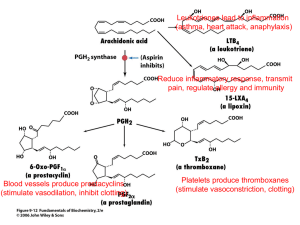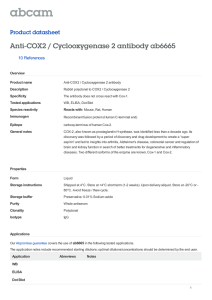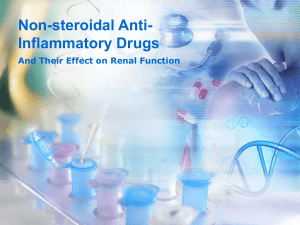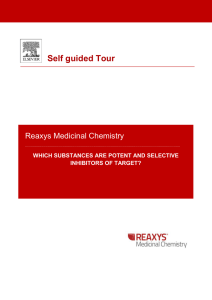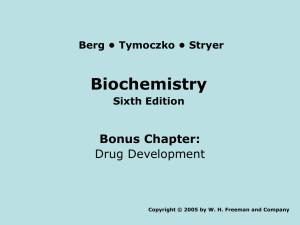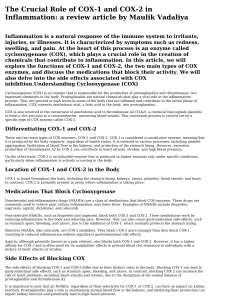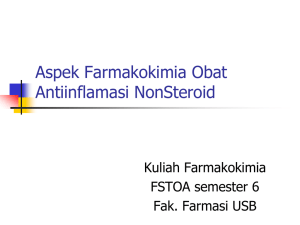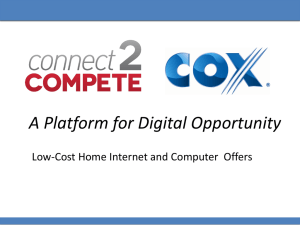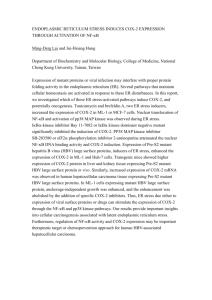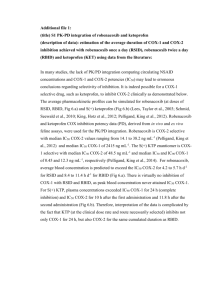COX inhibitors
advertisement
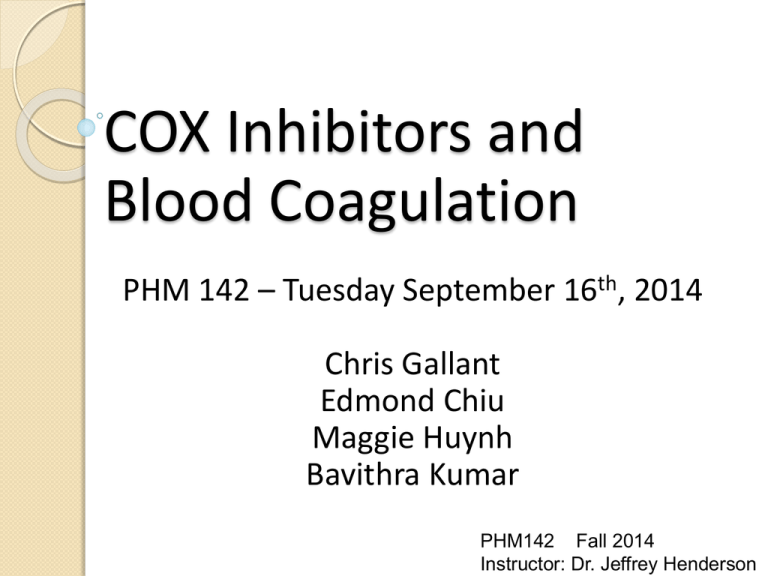
COX Inhibitors and Blood Coagulation PHM 142 – Tuesday September 16th, 2014 Chris Gallant Edmond Chiu Maggie Huynh Bavithra Kumar PHM142 Fall 2014 Instructor: Dr. Jeffrey Henderson What is COX? • Enzyme cyclooxygenase 1 • Responsible for the formation of prostanoids1 • 3 main groups of prostanoids include: • prostaglandins • prostacyclins • thromboxanes *These are all involved in inflammatory responses/are inflammatory mediators* What is COX? Two forms of cyclooxygenase enzymes exist: COX-1 -> present in most tissues1 ● e.g in GI tract it maintains the normal lining of the stomach. The enzyme is also involved in kidney and platelet function. 2,3 COX-2 -> primarily present at sites of inflammation1 What is Blood Coagulation? Adapted from reference 5 COX’s Relationship to Blood Coagulation ● COX plays a role in cessation of bleeding 4-6 ● COX activates a chemical known as thromboxane A2 4-6 ● The aggregation of platelets, in concert with the clotting process, results in a fibrin clot which stops bleeding and aids repair of the blood vessel. 7 What are COX inhibitors? • A class of drugs that target the cyclooxygenase enzyme and act as an effective treatment to pain and inflammation. Also known as nonsteroidal anti-inflammatory drugs (NSAIDs).8 • Can be nonspecific (target both COX-1 and COX-2) or specifically target COX-2.8 • COX-2 inhibition is desirable since this will reduce pain and inflammation in certain areas, while COX-1 inhibition is associated with side effects, such as stomach lining damage and gastric ulcers.8 http://img.wikinut.com/img/297i4cfbldfkof_v/jpeg/0/Ibuprofen-Advil-tablets.jpeg http://a.espncdn.com/photo/2007/1112/pg2_a_aleve_300.jpg How COX Inhibitors Work • Decrease the production of prostaglandins, which promote pain, inflammation and fever.9 • Prostaglandins also protect the lining of the stomach and intestines, promote blood clotting, and affect kidney function.9 • COX inhibitors are taken orally, and after absorption into the bloodstream they bind to the cyclooxygenase enzymes. COX-1 is found in all tissues constitutively, while COX-2 is induced by inflammation.9 • Binding can be reversible or irreversible.7 http://www.cheapmedicinechest.com/wp-content/uploads/2010/03/Figure-2-Nonselective-nonsteroidal-anti-inflammatory-drugs.png http://publications.nigms.nih.gov/structlife/images/ch4_valine.gif Aspirin and COX: Mechanism of Action • • • Serine acetylation3 Non-selective3 Irreversible3 Adapted from reference 4 Issues with COX-2 specific inhibitors • COX-2 inhibition reduces prostacyclin production, which is an important prostaglandin that prevents platelet clumping.9 • Without prostacyclin, platelets can build up and clump, leading to increased heart attacks and strokes in patients. Since COX-1 is unaffected, thromboxane A2 contributes to thrombosis as well.9 • Examples are Vioxx and Bextra, which have both been discontinued.9 http://img.timeinc.net/time/covers/1101050228/map/viox.gif Case Study COX-2 inhibitors used to treat pain after surgery 10,11 Possible complications? ◦ Increased risk of thrombosis Concern in Coronary-Artery Bypass Grafting (CABG)? Factors Considered CABG increases thromboembolic events: ◦ Platelet activation Pre-exisiting cardiovascular conditions12 Sheer stress from atherosclerosis ◦ Ischemia13 During procedure14 COX-2 inhibitors increase risk of thrombosis Clinical Data Figure adapted from reference 15 Conclusion of Study Risk outweighs benefits16 Advised to discontinue use of COX-2 specific inhibitors after CABG16 ◦ Drug discontinued in 2005 Skit To exemplify case study in clinical setting Enjoy! Summary Slide COX is an enzyme cyclooxygenase responsible for the formation of prostanoids which are involved in inflammatory response COX plays a role in cessation of bleeding and activates a chemical known as thromboxane A2 which relates to blood coagulation and platelet aggregation COX inhibitors nonspecifically bind to COX-1 and COX-2 or specifically bind to COX-2. Binding to COX-2 is desirable for reducing inflammation, pain and fever as it also avoids gastric ulceration. This effect is caused by reducing prostaglandin production. COX-2 inhibitors should be avoided when risk of thromboembolic events is higher References 1. 2. 3. 4. 5. 6. 7. 8. 9. Eustice, C. (2014, May 19). What Is Cyclooxygenase (COX)?. About Health . Retrieved September 15, 2014, from http://osteoarthritis.about.com/od/osteoart Lipsky, A. J. (n.d.). Clinical Considerations for Gastric Protection in the Presence of NSAID Therapy. Medscape. Retrieved September 15, 2014, from http://www.medscape.org/viewarticle/4739 University, Department of Epidemiology and Preventative Medicine. (n.d.). How Aspirin Works. How Aspirin Works. Retrieved September 15, 2014 from http://www.aspree.org/AUS/aspreecontent/aspirin/how-aspirin-works.aspx Ophardt, Charles. "Prostaglandins." Virtual Chembook. N.p., n.d. Web. 15 Sept. 2014. <http://www.elmhurst.edu/~chm/vchembook/555prostagland.html>. "How The Blood Clots." How Does Blood Clot? Coagulation Explained, Diagram, Blood Clotting Process, Stages, Hemostasis. N.p., 2010. Web. 15 Sept. 2014. Rhoades, Rodney , and David Bell. "Blood Clotting." Inkling. Wolters Kluwer, n.d. Web. 15 Sept. 2014. https://www.inkling.com/read/medical-physiology-rodney-rhoades-david-bell-4th/chapter-9/bloodclotting. Stenina, Olga, and Edward Plow. "MET orchestrates cancer and blood coagulation." Nature.com. Nature Publishing Group, n.d. Web. 15 Sept. 2014. <http://www.nature.com/nm/journal/v11/n4/fig_tab/nm0405376_F1.html>. McGettigan, P. and Henry, D. (2000). Current problems with non-specific COX inhibitors. Curr Pharm Des, 6(17): 1693-1724. Eustice, Carol. Cyclooxygenase: COX-1 and COX-2 explained. About Health, http://osteoarthritis.about.com/od/osteoarthritismedications/a/cyclooxygenase.htm (accessed September 10th, 2014). References 10. Daniels, S. E., Grossman, E. H., Kuss, M. E., Talwalker, S., & Hubbard, R. C. (2001). A double-blind, randomized comparison of intramuscularly and intravenously administered parecoxib sodium versus ketorolac and placebo in a post—oral surgery pain model. Clinical therapeutics, 23(7), 1018-1031. 11. Ng, A., Smith, G., & Davidson, A. C. (2003). Analgesic effects of parecoxib following total abdominal hysterectomy†‡. British Journal of Anaesthesia, 90(6), 746-749. 12. Konstantopoulos, K., Grotta, J. C., Sills, C., Wu, K. K., & Hellums, J. D. (1995). Shearinduced platelet aggregation in normal subjects and stroke patients.Thrombosis and haemostasis, 74(5), 1329-1334. 13. Park, J. L., & Lucchesi, B. R. (1999). Mechanisms of myocardial reperfusion injury. The Annals of thoracic surgery, 68(5), 1905-1912. 14. Wan, S., LeClerc, J. L., & Vincent, J. L. (1997). Inflammatory response to cardiopulmonary bypass mechanisms involved and possible therapeutic strategies. CHEST Journal, 112(3), 676-692. 15. Nussmeier, N. A., Whelton, A. A., Brown, M. T., Langford, R. M., Hoeft, A., Parlow, J. L., ... & Verburg, K. M. (2005). Complications of the COX-2 inhibitors parecoxib and valdecoxib after cardiac surgery. New England Journal of Medicine, 352(11), 10811091.
